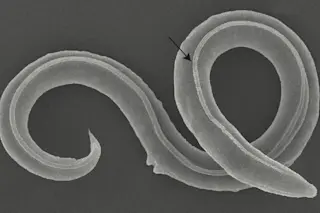A 46,000-year-old gopher hole in Siberia served as a time capsule for some very old plant material and a small nematode roundworm, which was later revived, according to a new study.
Researchers from the Soil Cryology Lab in Russia extracted the contents of the hole from Duvanny Yar outcrop in Siberia, a sheer wall of prehistoric sediments. Ancient rodents had dug the burrow, about 10 inches wide, during the Last Ice Age, and cold temperatures had since frozen it into permafrost that never thaws.
The scientists took the frozen sediment back to the lab, began to thaw it out, and were surprised to witness the nematode crawl out on its own, as if nothing had happened. While the worm resembled Caenorhabditis elegans, a model nematode used in countless experiments, the researchers found important differences and declared the ancient worm a new species: Panagrolaimus kolymaensis.
Other Revivals of Ancient Organisms
Ancient animals or bacteria revived after millennia form a small genre within the scientific literature.
In 1995, scientists announced that they had revived and cultured bacteria trapped in 25 million to 40 million years old amber.
And in 2021, they defrosted and revived tiny aquatic animals called rotifers that had been trapped in Siberian permafrost for about 24,000 years.
Against the Odds
How do such tiny animals prosper as if nothing had happened? P. kolymaensis, an all-female species that reproduces asexually, made itself at home in the Russian lab and reproduced for at least 100 generations. The specialists in cryology tried to explain why the founding worm of this population, now dead, had come through a 46,000-year-old ordeal in such fine shape.
Experiments showed that for a nematode to survive, it first had to go through a period of relative dryness, a “preconditioning,” to prepare for extreme desiccation and freezing. While in this phase, the nematodes’ bodies invested great energy in producing an antifreeze (and also water-conserving) chemical called trehalose that protects the worm for millennia, if needed.
“This raises the question of whether there is an upper limit to the length of time an individual can remain in the cryptobiotic state,” researchers ask in the new paper. “Long timespans may be limited only by drastic changes to the environment such as strong fluctuations in ambient temperature, natural radioactivity or other abiotic factors.”
What Is Trehalose?
According to a 2013 paper in Scientific Reports, trehalose is a special sugar that wraps around proteins and prevents the water inside the protective bubble from freezing. When the nematodes feel a dry coolness coming on, they produce this sugar at a rate 20 times greater than normal.
Trehalose also protects cells from desiccation, and researchers have used it to protect plants such as tomato plants against dry conditions. In nature, certain plants, including the highly drought-resistant “resurrection plants,” produce significant amounts of the chemical.
Humans produce their own trehalose and use it in the food industry, where it serves as a preservative and inhibits the breakdown of proteins and carbohydrates. Researchers have also studied whether the chemical’s protective powers could work as a treatment for Alzheimer's Disease and Huntington’s Chorea.
Read More: Scientists Might Bring Back These Extinct Animals














